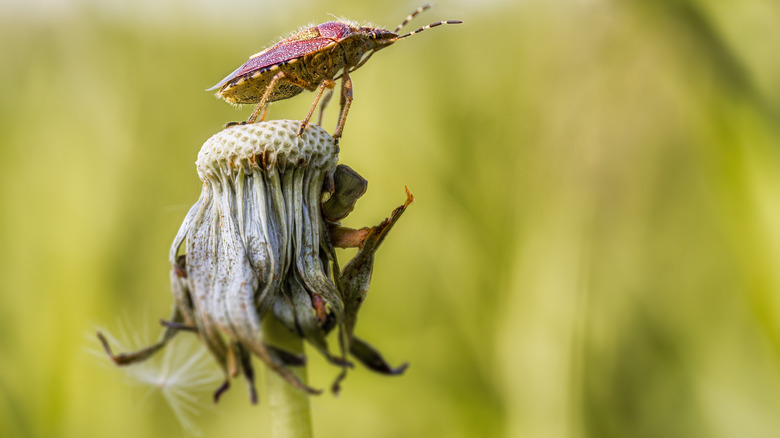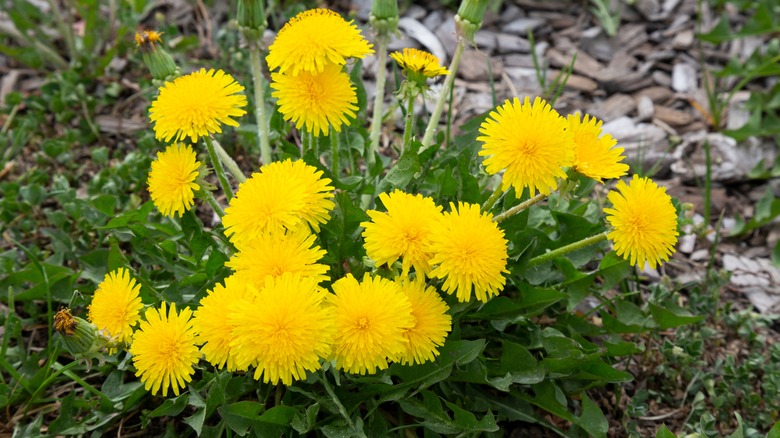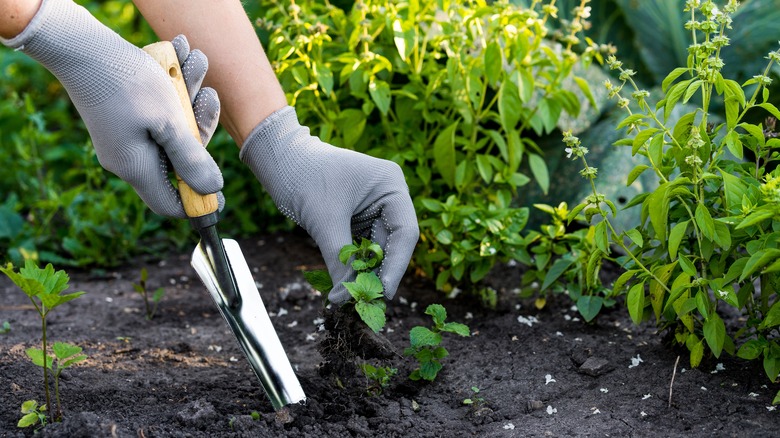The Lawncare Mistake That's Attracting Bugs To Your Yard
If you're constantly battling pests in your yard, you might want to take a closer look at the weeds. Often overlooked, these unwelcome guests — such as dandelions — not only compete with your lawn and garden plants but also serve as a buffet for various insects. In the cooler fall months, when other food sources are scarce, these weeds become particularly attractive to pests. Weeds, by their very nature, are resilient and resourceful plants. They thrive in environments where other plants struggle, often exploiting weak spots in your lawn. This hardiness makes them a reliable food source for pests like gnats, flies, and beetles.
In some instances, the relationship between specific weeds and pests is so strong that gardeners use certain insects as a biological control method. For example, the aphthona beetle is introduced to areas where leafy spurge, a harmful weed, is prevalent. These beetles lay their larvae in the roots of the weed, and upon maturing, the larvae consume the weed, ultimately destroying it.
However, such biological control methods come with their own risks. While these insects target the weeds, they can also turn their attention to healthy plants, causing unintended damage. Moreover, the presence of these pests can attract other predators, creating a complex ecosystem in your yard that may do more harm than good, hence the need to get rid of the weeds first. Interestingly, not all aspects of weeds are negative. Dandelions, for instance, can be beneficial to lawns. The trick is to balance their benefits against their potential for attracting pests.
Balancing the benefits of weeds like dandelions
As mentioned, dandelions, often dismissed as pesky weeds, actually offer some surprising benefits for your lawn. These yellow-flowered plants can improve soil health by aerating the ground and increasing nutrient availability. However, the nectar and pollen of dandelions are a food source for various insects, including those that can be harmful to other plants in your garden. This makes managing their growth a critical aspect of pest control. One effective method to control pests around dandelions is the use of diatomaceous earth. You can sprinkle this naturally occurring substance around dandelion-infested areas. It dehydrates and physically damages the exoskeletons of insects that come into contact with it. Importantly, when applied to the ground, diatomaceous earth is less likely to impact beneficial insects like bees, which are crucial for pollination and generally don't frequent ground level. This method provides a way to control pests near dandelions without eliminating the dandelions themselves, or harming beneficial insects.
Also, instead of aiming to completely eradicate them, you can try to control their population at a manageable level. In doing so, you can maintain the ecological benefits they bring, while reducing the likelihood of significant pest problems. To do this, manually remove larger clusters or target areas where dandelions are particularly dense. This approach requires you to monitor the growth of the dandelions to ensure they remain beneficial, and don't tip the balance unfavorably towards attracting pests.
The right way to pull out weeds
Whether you're removing dandelions or other invasive weeds, it's essential to get the whole root system out. If you leave any part of the root behind, the weed is likely to grow back — often more vigorously than before. Use a weeding tool or your hands to gently but firmly pull the entire weed out, roots and all. For more stubborn perennial weeds with deeper roots, you might need to dig around the base to loosen the soil and facilitate complete removal. Be thorough but gentle to minimize disturbance to the surrounding plants. After pulling out the weeds, throw them away properly. Don't leave them lying in the yard, as they can attract more pests, not to mention the risk of their seeds spreading and causing more weed problems.
In some situations, especially when dealing with a large number of weeds (or particularly resilient species), herbicides can be a more practical solution. If you choose to use herbicides, consider a targeted approach. A localized herbicide spray allows you to directly target the weeds without affecting other plants. After applying herbicides, give them time to work. This may take a few days to a week, depending on the product and the weeds you're targeting. Lastly, in addition to eliminating weeds, it might help to implement a pest management (IPM) strategy — this is an environmentally friendly way to control pest populations. It uses a mix of techniques, like biological control, changing the environment, and using plants that deter pests.


